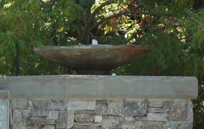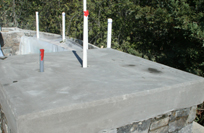Planning on Concealment
By Paolo Benedetti
 Once you start thinking along the lines of putting visual clutter out of sight, it's as though a whole range of interesting concealment possibilities begin presenting themselves.
Once you start thinking along the lines of putting visual clutter out of sight, it's as though a whole range of interesting concealment possibilities begin presenting themselves.
Case in point: My early work in stashing hoses in buried utility boxes triggered thoughts about hiding other bits of deck "plumbing" that do a remarkable job of disrupting a space's overall visual charm. The first thing that came to mind was all of the green- or black-plastic, quarter-inch water lines rising up the sides and over the edges of large pots to bring the convenience of drip irrigation to plant maintenance.
These systems are great, even indispensable in areas where it gets hot. But they are also ugly and subject to being nicked or cut or in other ways damaged.
My solution: If I know there are going to be large potted plants, I plan for their placement and prepare the site so their sources of water (and some other features) are completely concealed.
Potted Potential
 Once pot or container placements are settled, we ensure that drains are stubbed up from the deck surface along with water lines and conduits for insertion of wires associated with low-voltage lighting (Figure 1).
Once pot or container placements are settled, we ensure that drains are stubbed up from the deck surface along with water lines and conduits for insertion of wires associated with low-voltage lighting (Figure 1).
Before a pot is lifted into position, we drill a hole in its base large enough to accommodate the various pipes, lines and conduits. Once placed on the deck in its final position, we fill the bottom of the pot with several inches of non-shrink grout, effectively sealing it.
When that's dry, we slather the entire inside of the pot with a waterproofing emulsion to prevent any seepage or leaking through the bottom. We then trim and cap the drain pipe with a domed atrium grate wrapped with filter fabric to prevent clogging. Then comes a layer of 3/4-inch rock topped by more filter fabric, again to ensure adequate drainage.
Once that's ready, we'll trim the water line and attach a spray head or drip emitter (see the image that opens the article, above). Finally, we work with the low-voltage wiring, either placing a small fixture in the pot or running it up an adjacent wall, post or downspout to power some overhead lighting.
It doesn't take much beyond a bit of planning to eliminate the homeowners' need to hand-water their potted plants and trees - and to do so in ways that hide the more practical side of what it takes to help them thrive.
One last, key point: Don't forget the drains! Incorporating them into well-waterproofed pots prevents the appearance of unsightly mud, water and mineral staining that might accumulate around a pot's or container's base as a result of any over-watering.
And that artfully completes another exercise in concealment.
